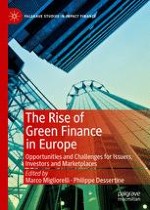2019 | OriginalPaper | Buchkapitel
2. Defining Green Finance: Existing Standards and Main Challenges
verfasst von : Romain Berrou, Nicola Ciampoli, Vladimiro Marini
Erschienen in: The Rise of Green Finance in Europe
Verlag: Springer International Publishing
Aktivieren Sie unsere intelligente Suche, um passende Fachinhalte oder Patente zu finden.
Wählen Sie Textabschnitte aus um mit Künstlicher Intelligenz passenden Patente zu finden. powered by
Markieren Sie Textabschnitte, um KI-gestützt weitere passende Inhalte zu finden. powered by
